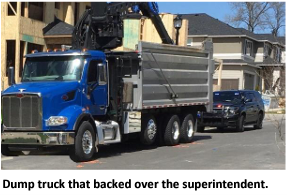Original article published by NIOSH

On the day of the incident, the superintendent was in charge of coordinating and directing subcontractors and scheduling dump trucks to haul away construction debris. Two dump truck drivers employed by a solid waste recycling company were emptying dumpsters and hauling away the debris. While emptying a dumpster, a 5-gallon bucket of paint fell out and spilled on the street. The superintendent came over to organize the cleanup. He assigned one of the subcontractors to get sawdust to absorb the paint and told the drivers he was going to direct vehicles away from it. The drivers then entered their trucks to go pick up the next dumpster located close to the spilled paint. The trucks had to be parked side-by-side as the grapple on one truck needed to pick up the dumpster and empty it into the other. The driver of truck #1 drove out of the alley, turned right, and parked on the side of the street near the superintendent. The driver of truck #2 then turned left onto the street, drove forward, and stopped. He checked his mirrors and got a hand signal from the superintendent to begin backing up. As he was backing up, he lost sight of the superintendent and ran him over. The incident was unwitnessed. It is unknown why the superintendent was in the backing zone, or why the driver could not see him.
Following the incident, investigators found:
- The truck did not have a backup camera, nor was an observer signaling that it was safe to back up.
- The truck’s backup alarm was working as it backed up.
- The truck drivers were not trained on procedures for backing up at construction sites.
REQUIREMENTS
- Before backing a dump truck, the driver must determine that no one is currently in the backing zone and it is reasonable to expect that no employee(s) will enter the backing zone while operating a dump truck in reverse. If employees are in the backing zone, you must make sure the truck is backed only when: An observer signals that it is safe to back or an operable mechanical device that provides the driver a full view behind the dump truck is used, such as a video camera. See WAC 296-155-610(2)(f)(ii)
- It is the responsibility of management to establish, supervise, and enforce, in a manner which is effective in practice training programs to improve the skill and competency of all employees in the field of occupational safety and health. See WAC 296-155-100(1)(c)
RECOMMENDATIONS
FACE investigators concluded that to help prevent similar occurrences: General contractors at multi-employer job sites should:
- Continuously assess the hazards of vehicles to workers on foot and ensure hazards are corrected.
- Require workers to wear ANSI Class 2 high-visibility garments, such as vests, when exposed to vehicular traffic. Employers who use dump trucks should:
- Consider installing pedestrian proximity detection systems on trucks to alert drivers of workers on foot.
- Train drivers that they must use a signaler or back up camera when backing near workers on foot.
- Create and enforce policies that:
-
- Drivers maintain visual contact with workers on foot. When visual contact is lost, drivers should stop and not resume movement until visual contact is re-established.
- Workers on foot stay out of backing zones unless trained and acting as an observer signaling the driver.
McCraren Compliance can help you understand and comply with FMCSA, USDOT and ADOT and ensure your drivers and your vehicles operate safely and efficiently.
Call us Today at 888-758-4757 or email us at info@mccrarencompliance.com to schedule your free FMCSA Compliance Assessment.